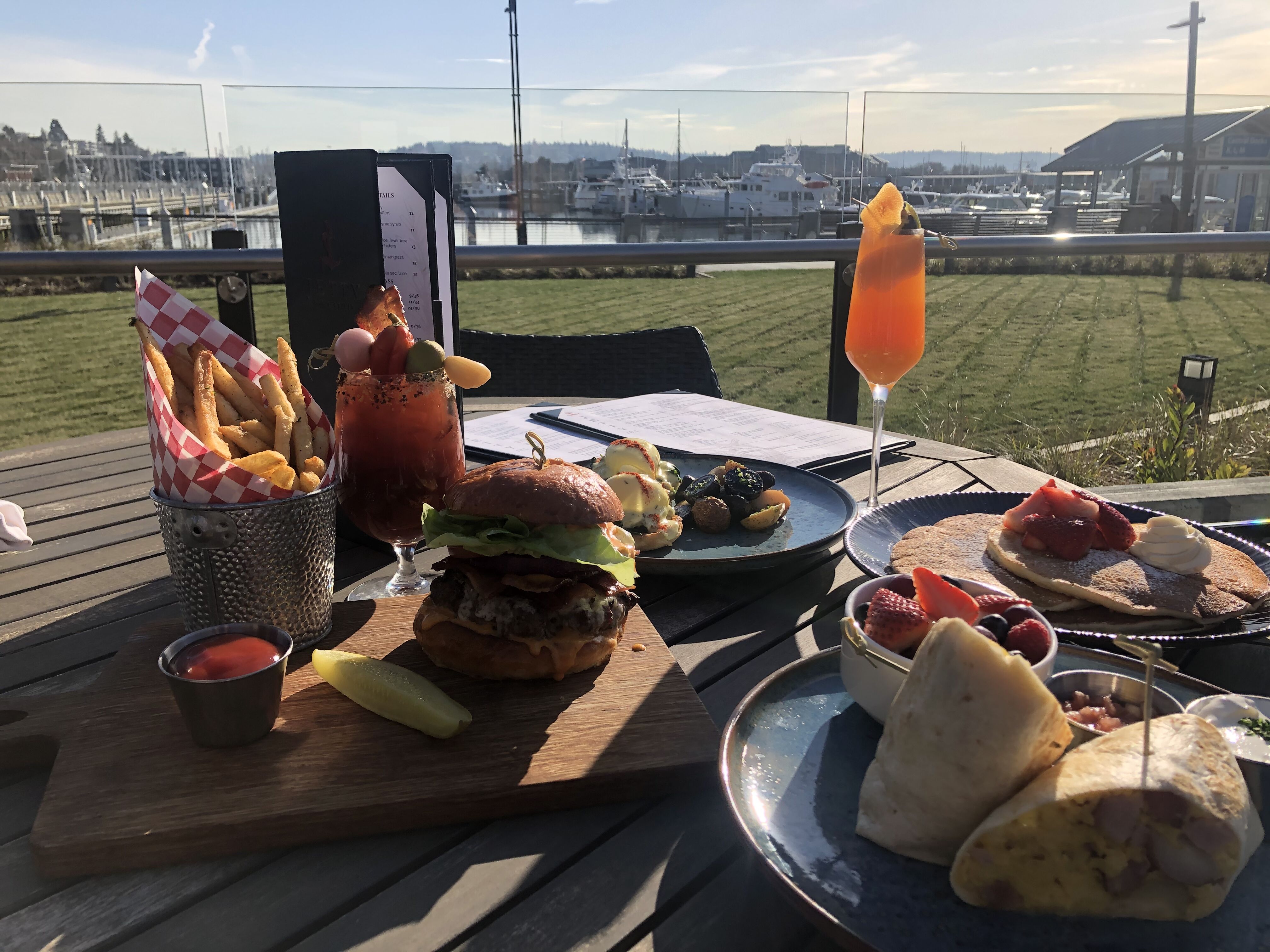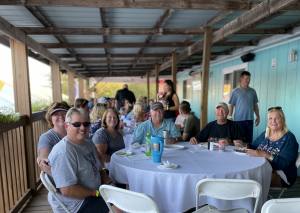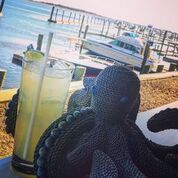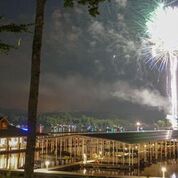
Marina Restaurants Add Important Amenity and Profits Too
Published on March 18, 2020Like marinas across the country, their waterfront restaurant operations vary greatly, from counter service pizza joints to medium-sized in-house operations and third-party operators to upscale dining destinations. Some view the restaurant operations as a necessary amenity and not a big profit maker, but for others the restaurant is a center piece of the waterfront destination. Each facility will need to find what type of food service is right for their location, their boaters and their atmosphere, but these marinas shared their experiences, tips and recommendations for building a successful waterfront restaurant and why it’s important to their marina operations.
Small but Nimble
Hoosier Hills Marina on Patoka lake in southwestern Indiana expanded service and menu options at its small, but nimble kitchen. The restaurant is open typically from May to September, with weekend operations starting in April.

It opens from 8 a.m. to 8 p.m. on the weekends and closes at 6 p.m. during the week. The restaurant is known locally for its pizza, also serving fresh salads, appetizers and sandwiches, and continually bringing in new menu items and specials. Last year, it added breakfast service.
Part of the success of the restaurant was fed from dock expansions at the marina. The number of slips grew by 50 percent from 2017 to 2019, and it naturally brought in more customers.
In addition to dock renovations, owners Victor Polen and Rebecca Masters upgraded the marina store and restaurant area, adding a new pizza oven, commercial freezer and kitchen supplies, such as cheese warmers and a panini maker. The changes also included a remodel of the marina store area, restaurant and sales counter area.
“The prior layout was setup like a home kitchen table or someone’s living room. We completely changed that,” Polen said. The prior layout was not inviting, and customers felt that. The new space has more privacy around the kitchen area and counter space and feels more welcoming to customers. The owners also did a lot to promote the restaurant and new additions on social media.
“It really has taken off. We’ve increased the number of people that have learned about restaurant. We have really great pizza, and we’re getting that name recognition,” Masters said.
Some of the changes at the restaurant are hard to quantify, Polen said. It stems from a changes they made to the environment at the marina, starting with the dock hands that tie up visitors to the dock, all the way until customers exit the property.
After the first year of operations, Masters knew they had an opportunity to expand the menu. On its annual boater survey, they asked three questions about the restaurant and menu. In general, customers wanted more menu items. “We don’t have a lot of space, so we had to grow with what we had,” Masters said, and their customers responded with big demand.
In the near future, the Idle Zone Restaurant hopes to add alcohol service, but that has been a long haul and a big cost. Alcohol service will start in 2020, but the marina had to work with the local Department of Natural Resources to amend the lake policy in accordance with the law. It took two years and thousands of dollars in legal fees.
“We have a captured audience, but we could very easily lose that if we didn’t keep up our quality and change up our menu,” Masters said.
At Hoosier Hills Marina, the marina store and restaurant work in tandem. The store is an important profit center for the marina, especially after its expansions. “The marina store and restaurant work hand in hand,” Polen said. “They feed off each other.” Someone comes in to buy a t-shirt or the newest trinket and they discover the restaurant, or vice versa. The marina, restaurant and store operates with a small staff, and the small restaurant can operate with one to four employees, depending on the time and season.
When they bought the restaurant, Masters said they expected the restaurant would be more of an amenity than profit maker. “So we were pleasantly surprised.
We went into it thinking we wouldn’t be making any money on it, and we did,” Masters said. Family Joint Norris Landing Marina in Tazewell, Tennessee, runs a much larger restaurant operation in-house. Jimmy’s Place is a family restaurant atmosphere, with a full bar and music entertainment on the weekends. The restaurant is open from Memorial Day to Labor Day, seven days a week, typically from 9 a.m. to 11 p.m. During the spring and fall, the restaurant operates with 10 employees, and during peak season, it can employ up to 50.
Matt Smith, managing partner at Norris Landing Marina, said the restaurant business can be profitable, but it’s not easy. He said counting on the restaurant revenue to support their business could be scary, but it can bring in extra profit – feast or famine.
At the fairly remote Norris Lake, the restaurant traffic is highly affected by the weather. When it rains, people stay home. Smith also said for a hands-on general manager, the restaurant doesn’t need a separate manager, even with such a large staff. He has department supervisors for the kitchen and front of the house, but he oversees both the marina and the restaurant.
With the seasonal business, Smith said the marina has also used the restaurant space for events, including catering from the restaurant, during the winter – for banquets, weddings or class reunions. During the main restaurant and boating season, Jimmy’s Place brings in regular entertainment on the weekends. Smith uses a talent manager to book local musicians. The marina owners had an existing relationship with a local radio station manager, who helps book a variety of bands and singers. They usually bring with them a local following to the marina events, Smith said.

A lot of people call the marina “Jimmy’s,” and it’s helped create a destination on the lake, Smith said, which continues to feed customers to the waterfront. “It’s all about boat traffic, and people being on the lake,” Smith said. He often checks boat rentals on a busy day, which can boost restaurant sales. “If rentals are going out, I can bet they’ll come back and have a meal,” he said.
Third-Party Operation
Boaters at Cedar Island Marina in Clinton, Connecticut, frequent Rocky’s Aqua Restaurant, a 275-seat operation, which has two full bars and a large deck overlooking the water. It serves American seafood cuisine. Restaurant patrons can dock at the marina for free, and the restaurant is open seven days a week from May to October, then services goes to Wednesday to Sunday until December, when it closes until about mid-April.

Kris Shapiro’s dad bought the marina in 1974. During the 80s and 90s, his father ran the marina and restaurant with a business partner, who ran the restaurant. When his partner left, Shapiro took over the restaurant operations for a number of years.
“I think it became too stressful having the long hours of running the marina and the nighttime hours at the restaurant. He enjoyed the marina much more,” Shapiro said. And in the 90s, he started renting out the restaurant space to a third-party operator. Today, the operator pays a set rental fee for a fully furnished restaurant, and the business operate separate of the marina. “It’s an amenity for the seasonal customers,” Shapiro said. “It does bring in a lot of transient traffic.”
The restaurant has music on the weekends, usually a two- or three-piece ensemble. “They used to do full band, but it got too crazy,” Shapiro said. Weekend events bring a lot of extra people down to the marina. “The restaurant is a great thing that gives people access to the water without needing a boat or a waterfront cottage,” Shapiro said. The extra traffic on the lake and at the marina is always good for business.
“The big thing for us is getting people onto our property and onto the shoreline to see what is there and become knowledgeable about it,” Shapiro said. “They might turn into customers down the road, once they see up close all that we have to offer.”
Hybrid Centerpiece
At Twin Creek Marina on Tims Ford Lake, Tennessee, the upscale restaurant Drafts & Watercrafts opened with the new marina in April 2018. From the beginning of the development, the restaurant was set up to be a center piece of the resort, and a lot of planning went into its design and concept.
Jeff Kenney, one of the owners of Twin Creek Marina and Resort, said, “We looked at restaurants all over, and they seemed to be an afterthought in a lot of cases.” Kenney wanted to take a different tactic with their property. “We wanted to add an amenity that shines and could stand alone,” Kenney said. Likewise, they were not restauranteurs, so they found a partner who already had a restaurant business, and together they formed a hybrid partnership. The marina operation wasn’t renting space to the restaurant operation to run independently, rather they both have a stake in the profits of the restaurant and operate as a cohesive partnership. Kenny said the restaurant manager runs the operation with some minimal oversight, and the hybrid operations has far surpassed their expectations.

“When we first opened the restaurant and the marina, we had high expectations,” Kenney said. “But we had no idea how much demand there really was in the area.” The restaurant opened with seating for about 150, with a bar area and some outdoor patio seating. Customers were waiting two hours to get into the restaurant the first year. “We just did not account for the demand,” Kenney said. “We’re the only people that build a brand-new facility and renovate after 12 months.”
But that’s what they did, doubling the size of the kitchen and adding a second bar and sitting area. They also covered the entire patio area, where the hot sun had kept people from lounging for long periods of time. The second year, the changes doubled restaurant revenues. “It really jettisoned all the other parts of business, especially rental boats,” Kenney said.
The marina and restaurant is fairly close to a big town of about 35,000 people. At less than half-mile from downtown, the restaurant serves a steady lunch rush from Winchester.
The marina and restaurant also support event services on-site. This year, they have 40 events planned. They have hosted fundraisers for the Governor, corporate events for Nissan and weddings. The resort employs a full-time event coordinator, who can plan entire events, including catering from the restaurant and bar service, and any third-party services needed on-site.
Mixed-Use Development
At the Port of Everett in Washington, $30 million has been invested into the marina over the last decade and $550 million is going into developing the once industrial and commercial property into a mixed-use development meant to give the community recreational space at the waterfront. The new Waterfront Place development, which includes more than 1.5 million square feet of upland space, has hotels, apartments, public access amenities, retail/commercial properties, and restaurants, lots of restaurants. The overall development project is in the first of three phases. It currently has nine restaurants, with plans to add six more.
“Waterfront Place is the district’s gift to its constituents, and a place that represents the community,” said Terrie Battuello, chief of business and economic development at the Port of Everett.
She wears many hats for the port in economic development, recruitment and acquisition, and she works with the many different businesses that are choosing to call Waterfront Place home. Of all the different types of deals Battuello is making for the new property, restaurant deals are the most complicated. “They are the hardest to make work,” she said. As a business in general, restaurants are tough because customers are fickle. Restaurants must have a constant need to reinvent themselves, Battuello said.
Additionally, the Waterfront Place isn’t looking for large corporate chain restaurants.
“We’re looking at a more boutique operation, around 2,500 square feet,” Battuello said. The risk for a small operator is also much higher, she said, which further complicates deals. The port’s grand vision for the development is shared by each of its renters and the businesses on sight.
“We want to make sure people have an experience that is unique to our place,”
Battuello said. The brand and the port’s history and culture is referenced in the names of the streets and the design of the open spaces, the furniture and street lights.
“The development is intended toprovide experiences you can’t get somewhere else,” Battuello said. A cookie cutter restaurant would never work for the property, and the port is willing to work with the right small establishments, if it can provide a signature experience.
The port is more willing to work with restaurant operators on negotiating terms of the lease, because those small operations often need extra time to establish themselves. Where the port might, for example, want to monthly rent based on $30 per square foot, the new restaurant operation, based on what it’s projecting for revenues, may only be able to pay $15 per square foot with confidence. So the port will establish a lease with that base amount, and based on growth of the business, the restaurant will pay a certain percentage over that base as more revenue comes in. The long-term structured deals give small restaurants more time to get established.
Overall, Waterfront Place is intended to create a baseline of revenue for the port. “It’s risky upfront, but stable once it’s established,” Battuello said. The revenues from the are very cyclical, she said. The commercial real estate investment keeps the baseline revenue up, and the port uses the cyclical revenues from the marina (boom or bust) for long-term capital investment.
All the properties and businesses must also be considered as a whole. “If an opportunity presents itself for a restaurant, we have to think about how it affects the entire rubric,” Battuello said. “The order that we sign leases is also very important.”
The port also wants to make sure Waterfront Place isn’t just a summer destination, and restaurants are an integral part of making the waterfront enjoyable year-round.
Profit Center or Amenity
Food and drink will always be a part of waterfront recreation, on the boat or at the shoreline. Whether a marina serves snacks and sodas or a full-service fine dining experience, it should be tailored to the property and boaters, and the demand of the local market. It may not always be an easy business and sure- fire profit maker, but restaurants continue to be a large part of marina operations. Some choose to outsource that service to third parties, run that operation in tandem with the marina, or a hybrid of the two.
Across the wide scope of marina operations in the country, which vary greatly by their market and location, there probably lies another form of restaurant partnership somewhere between those ready for the perfect operation.
| Categories | |
| Tags |






